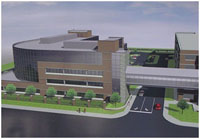
ST. VINCENT MERCY MEDICAL CENTER HEART PAVILION
TOLEDO, OH
| |
| BUILDING STATISTICS |
| THESIS ABSTRACT |
| TECHNICAL ASSIGNMENTS |
| THESIS RESEARCH |
| THESIS PROPOSAL |
| PRESENTATION |
| FINAL REPORT |
| REFLECTION |
| E-STUDIO HOMEPAGE |
| Note: While great efforts have been taken to provide accurate and complete information on the pages of CPEP, please be aware that the information contained herewith is considered a work‐in‐progress for this thesis project. Modifications and changes related to the original building designs and construction methodologies for this senior thesis project are solely the interpretation of Kristen Lechner. Changes and discrepancies in no way imply that the original design contained errors or was flawed. Differing assumptions, code references, requirements, and methodologies have been incorporated into this thesis project; therefore, investigation results may vary from the original design. |
Thesis Research
The following documents were drawn upon for the research and design carried out within this senior thesis project.
Model Codes and Standards:
- American Institute of Steel Construction. Manual of Steel Construction, 13th Edition. AISC: 2005.
Code used for steel design portion of this thesis project
- American Institute of Steel Construction. Seismic Design Manual. AISC: May 2006.
Code used to carry out detailing of the Reduced Beam Section Connections
- American Society of Civil Engineers. ASCE 7-05: Minimum Design Loads for Buildings and Other Structures. ASCE: Reston, VA, 2006.
Code used to determine applicable dead and live loads as well as lateral loads acting on the structure
Design References:
- Allen, David E., Murray, Thomas M., & Ungar, Eric E. Floor Vibrations Due to Human Activity. AISC Design Guide, 11.
A guide used to redesign the beams and girders supporting the operating room spaces
- Carter, Charles J., Stiffening of Wide-Flange Columns at Moment Connections: Wind and Seismic Applications. AISC Design Guide, 13.
A guide used to design the required stiffening for the RBS Connections (Alternatives I and II)
- FEMA. Recommended Seismic Design Criteria for New Steel Moment-Frame Buildings. FEMA 350. Washington, D.C., 2000.
A reference used to obtain an understanding of how seismic detailing requirements for steel moment frame buildings have changed since the 1994 Northridge earthquake and the 1995 Kobe earthquake
- FEMA. Recommended Post Earthquake Evaluation and Repair Criteria for Welded Moment-Resisting Steel Frame Structures. FEMA 351. Washington, D.C., 2000.
A reference used to research the different types of prequalified connections commonly used in steel moment frame buildings
- Gross, J. L., Engelhardt, M. D., Uang, C.M., Kasai, K., & Iwankiw, N. R. Modification of Existing Welded Steel Moment Frame Connections for Seismic Resistance. AISC Design Guide, 12.
A guide used to design the RBS Connections
Technical Articles:
- Iwankiw, Nestor. Seismic Design Enhancements and the Reduced Beam Section Detail for Steel Moment Frames. Practice Periodical on Structural Design and Construction. ASCE: May 2004.
An article used to learn more about the concept of how the Reduced Beam Section works
Miscellaneous References:
- RSMeans Construction Publishers and Consultants. Building Construction Cost Data 2008 66th Annual Edition. Reed Construction Data, Inc.: Kingston, MA, 2007.
A reference used to help estimate the cost of the redesigned foundation and lateral systems and the redesigned façade
- Stein, B. Reynolds, J.S., Grondzik, W. T., & Kwok, A.G. Mechanical and Electrical Equipment for Buildings. John Wiley and Sons, Inc.: Hoboken, NJ, 2006.
A book used to determine the R-values of the different materials within the brick veneer wall system
- Thompson, F., Haywood, G. G., Structural Analysis using Virtual Work. Taylor & Francis, 1986.
A book used to review the method of virtual work and how it applies to a frame
|
Senior Thesis | The Pennsylvania State University | Architectural Engineering | AE Labs | Contact Kristen |
This page was last updated on April 22, 2009 by Kristen Lechner and is hosted by the AE Department © 2009